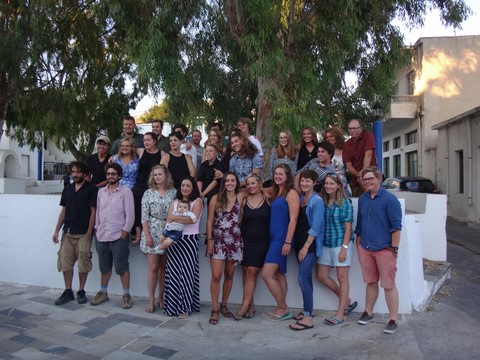Tristan Carter: Naxos-Neanderthals - the big paper
I encountered Prof. Tristan Carter of McMaster University, Canada, one month after Alfred de Grazia's death, in August 2014. Prof. Carter had been alerted to the signs of a very early hominin presence on the promontory of Stelida, on the Aegean island of Naxos, Greece. I had the great privilege of giving Prof. Carter and his Greek colleagues and their multinational team authorization to do archaeological excavations on Alfred's beloved land on Stelida, where he had built a little house in the early 1970s and where we lived part of the year. My neighbors Barbara Roesler and Anestis Kombokis also gave their authorization. The hearth site was found on Anestis' land. The evidence for the earliest human presence on any island in the Mediterranean in my garden.The following paper, just published in AAAS Science Advance presents the first official results of the research done by Prof. Carter and his team.
(Publisher of Q-MAG.org)

Prof. Tristan Carter to Anne-Marie de Grazia: October 16, 2019/21:11
>>>>>>>>>
Dear Anne-Marie
Well thanks to you we are changing history… Our first major / top-tier journal paper was published in the last hour (open access):
https://advances.sciencemag.org/content/5/10/eaax0997
Tristan
Undergraduate Chair / Associate Professor Dept. of Anthropology, CNH 524 McMaster University 1280 Main Street West, Hamilton ON, L8S 4L9, CANADA
Director The Stelida Naxos Archaeological Project (SNAP)
Director McMaster Archaeological XRF Lab (MAX Lab)
<<<<<<<<
Introduction
Understanding the global patterning of hominin and Homo sapiens’ dispersal is a key research theme for Quaternary scientists (1–2). Until relatively recently, a convincing case could be made that certain environments were uninhabitable for hominins (e.g., islands, deserts, and mountain ranges), with such regions’ subsequent colonization by anatomically modern humans (AMHs), a clear reflection of more evolutionarily advanced capabilities. Part of this larger argument held that major bodies of open water served as barriers to pre-sapiens populations, with seafaring seen as an index of behavioral modernity. Consequently, it was believed widely that hominin dispersals were restricted to terrestrial routes until the later Pleistocene.
Recent discoveries are requiring scholars to revisit these hypotheses. Excavation data now demonstrate that hominins were capable of occupying the high, semi-arid central Anatolian plateau with its strongly continental climate in the Middle Pleistocene, while Denisovans were capable of living at high altitude in East Asia. At another environmental extreme, debate has intensified over the role of coastal and marine environments in hominin and AMH evolution and dispersal, especially in areas that necessitate open-water travel. A case in point is the eastern Mediterranean’s Aegean Basin, a region that has been conspicuously neglected in the larger narrative of hominin dispersal for over a century. The prevailing view has held that the Aegean Sea—separating western Anatolia from continental Greece—constituted an impassable barrier to pre-sapiens populations. The likeliest entry point to Europe was consequently hypothesized to be the Marmara-Thrace land corridor. Recent archaeological and paleogeographic research, however, challenges this model.
Here, we detail evidence from excavations at the chert source of Stelida on what today is the island of Naxos in the middle of the Aegean Basin, where paleodosimetric dates suggest that hominins were present in the region by 200 ka ago, accessing the chert quarry during a glacial lowstand when exposed land connected Anatolia to continental Southeast Europe, by seafaring, or through some combination of the two. Here, we detail evidence from excavations at the chert source of Stelida on what today is the island of Naxos in the middle of the Aegean Basin, where paleodosimetric dates suggest that hominins were present in the region by 200 ka ago, accessing the chert quarry during a glacial lowstand when exposed land connected Anatolia to continental Southeast Europe, by seafaring, or through some combination of the two. Throughout the remainder of the Pleistocene, this region was occupied and/or traversed at least sporadically, including by early H. sapiens ~40 to 30 ka ago (who may have arrived by boat), and later by indisputably seafaring Mesolithic hunter-gatherers of the Early Holocene.. Throughout the remainder of the Pleistocene, this region was occupied and/or traversed at least sporadically, including by early H. sapiens ~40 to 30 ka ago (who may have arrived by boat), and later by indisputably seafaring Mesolithic hunter-gatherers of the Early Holocene...
The world takes note...
https://www.archaeology.org/news/8119-191018-greece-naxos-neanderthals
https://www.daily-sun.com/post/432114/First-Neanderthal-activity-found-on-Greek-island
https://phys.org/news/2019-10-scientists-early-humans-mediterranean-earlier.html
https://www.cnet.com/news/ancient-greece-just-got-tens-of-thousands-of-years-more-ancient/
https://www.sciencedaily.com/releases/2019/10/191016153642.htm
https://www.journaldequebec.com/2019/10/17/lhomme-de-neandertal-etait-present-sur-une-ile-grecque
https://rg.ru/2019/10/17/liudi-v-grecii.html (in Russian)
http://en.protothema.gr/early-humans-migrated-to-greek-islands-200-000-years-ago/
https://www.sciencedaily.com/releases/2019/10/191016153642.htm
https://newatlas.com/science/evidence-humans-greek-island-migration-timeline/
https://zap.aeiou.pt/neandertais-ocuparam-ilhas-mediterraneo-dezenas-milhares-anos-do-pensava-286505
https://greekcitytimes.com/2019/10/18/scientists-discover-naxos-inhabited-200000-years/
https://newatlas.com/science/evidence-humans-greek-island-migration-timeline/
https://www.cnbeta.com/articles/science/900591.htm (in Chinese)
https://www.obozrevatel.com/ukr/abroad/zhili-200-000-rokiv-tomu-arheologi-zrobili-sensatsijne-vidkrittya-pro-starodavnih-lyudej.htm (in Ukrainian)
https://www.facebook.com/archaiologiaonline/posts/2984110021606054
and more to come...


